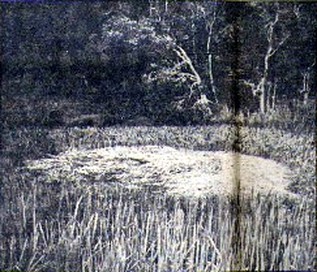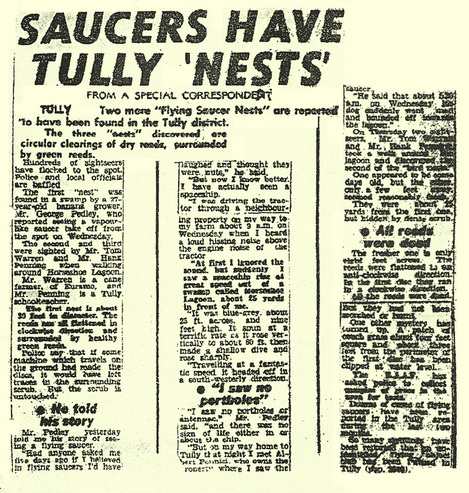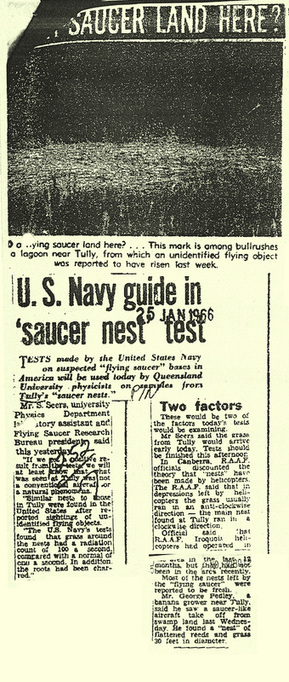1966 - Tully
The "saucer nests" of Tully, 1966 are undoubtedly the most famous circles known before the modern era. Even Doug Bower, who claimed to have started the crop circle phenomenon in 1978, cited Tully as his initial inspiration, remaining virtually mute on what might have caused the nests. (It definitely wasn't him; he once stated that local farmers had made them, without further explanation.)
Although these are universally called the Tully nests, they were in fact much closer to the very small town of Euramo, which lies to the south of Tully. The spot is known informally as Horseshoe Lagoon.
These are very widely documented, particularly in the crop circle press, where virtually all publications mention them. Although the body of literature pertaining to this event is sizeable, we will only provide a basic outline below. If readers want more detailed accounts, there is plenty of information available in books and on the internet.
Although these are universally called the Tully nests, they were in fact much closer to the very small town of Euramo, which lies to the south of Tully. The spot is known informally as Horseshoe Lagoon.
These are very widely documented, particularly in the crop circle press, where virtually all publications mention them. Although the body of literature pertaining to this event is sizeable, we will only provide a basic outline below. If readers want more detailed accounts, there is plenty of information available in books and on the internet.
Events begin with farmer George Pedley, driving a tractor on land belonging to Albert Pennisi in the Euramo area, on January 19, 1966. At around 9am, Pedley heard a hissing sound and then claimed to have seen a "flying saucer" rise from the swamp in Horseshoe Lagoon, and fly away.
Going over to investigate, Pedley discovered a circle of clockwise swirled reeds, measuring 30 feet in diameter (roughly 9 metres).
Later in the day, Pedley fetched Pennisi to witness the circle, and he not only did so, but waded out into the water (see photo, right). By doing so, Pennisi learned that the reeds were not bent over, but physically uprooted from the lagoon bed, and somehow swirled into a floating mat on the surface of the water.
Going over to investigate, Pedley discovered a circle of clockwise swirled reeds, measuring 30 feet in diameter (roughly 9 metres).
Later in the day, Pedley fetched Pennisi to witness the circle, and he not only did so, but waded out into the water (see photo, right). By doing so, Pennisi learned that the reeds were not bent over, but physically uprooted from the lagoon bed, and somehow swirled into a floating mat on the surface of the water.
|
This event is often thought to be an isolated case involving just this
one nest. However, there were several.
The local press took an immediate interest in the event and sightseers began to arrive. Two more nests were located, hidden among the thick swamp grass, and smaller than the first. One was swirled clockwise and the other anti-clockwise. Also found was a completely bare rectangle in the reeds, in which the plants had been uprooted and disappeared from the vicinity. As news continued to spread others came looking, and local farmer Lou Lardi found two more, with yet another discovered shortly afterwards, which exhibited a scorched centre. This made six nests at the site. The diagram, right, was drawn up by Peter Horne, based on an image from Australian Flying Saucer Review. It seems that this was not the first such incident in the Euramo region. The RAAF investigated this case, and noted, "During enquiries a number of local residents stated that the reported "nests" are fairly common during the onset of the "wet" [season]." This suggests that such circles had been seen repeatedly. Cases pre-dating 1966 are hardly recorded however. Ted Phillips has catalogued a similar nest from 1965, which is the only definite case on record. According to a report in Crop Watcher magazine (issue 14), Tully local and UFO researcher Claire Noble confirmed earlier cases had been reported. According to Andrew Collins, "Claire later confirmed that there were circles in both the reeds and in sugar cane before 1966, but their importance was never realised until after George Pedley's encounter." |
Location
|
Pictured to the right is an aerial photo of Horseshoe Lagoon today. By comparing the curve of the lagoon to the drawing above (which is oriented the same way) one can identify more precisely the spot where the 1966 nests appeared. Below is a map which shows the location in relation to Euramo and Tully. We would like to thank Greg Jefferys for confirming the location to us. |
Tully after 1966
The 1966 case is a notable event in the UFO world, and in
the context of later crop circles, is doubly important. Thus, Tully has
become famous as a UFO tourist attraction, Australia's equivalent to
Roswell (USA) or Alton Barnes (UK).
In the same article, Claire Noble confirmed that as of 1992, she had records of 86 markings in the region, stretching from 1965 up to date. She also has an unpublished photograph of a reed nest in nearby Dores Lagoon, dating to 1975. |
Other confirmed cases are on record from 1968, 1969, 1971, 1972, 1977, 1987 and 1992 - with several further circles reported in other years too. Some of the later cases have shown greater complexity, such
as multiple concentric rings.
One intriguing case from 1987, catalogued by Keith Basterfield, consisted of a curved formation - five circles arranged in an arc shape. This account has resonances with the Edwin Fuhr rings found in Langenburg, Canada, in 1974. |
Press coverage
historic old crop circles - related cases





















